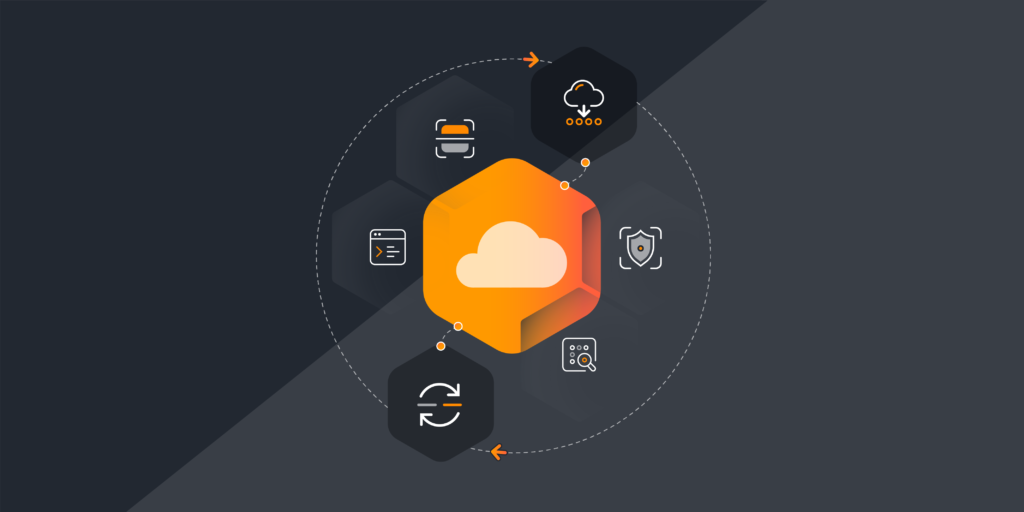
Introducing Lansweeper’s 2024 Summer Launch
Cloud migration involves moving an organization’s data, applications, and IT processes from on-premises infrastructure to cloud-based environments. In this blog post, we tell you everything you need to know about cloud migration, including what it is and why it’s important, the benefits you stand to realize, types of cloud models and other essential information to get you started on your cloud migration journey.
What Is a Cloud Migration?
A cloud migration begins with evaluating your current IT infrastructure and determining what needs to be migrated to the cloud. Handling data migration and synchronization correctly is critical to ensure everything remains consistent and accessible. Once migrated, it’s important to test the applications to confirm they function correctly and make any necessary adjustments.
Why Should You Migrate to the Cloud?
Migrating data and applications to the cloud provides the scalability to meet changing demands. The cloud enables flexible access to data and applications from anywhere, to support remote work and enable greater collaboration and timely decision-making. Another major benefit is cost savings. Moving to the cloud reduces the need for large capital investments in hardware by adopting a pay-as-you-go model. This shift allows organizations to optimize IT spending while cloud providers handle maintenance and upgrades, letting internal IT teams focus on strategic tasks.
Many cloud providers offer robust disaster recovery options and advanced security features like encryption, identity and access management, and regular updates, helping to protect sensitive data and meet regulatory requirements. Cloud services also offer robust disaster recovery and business continuity solutions which ensure data remains safe and accessible, even during hardware failures or other disruptions.
Types of Cloud Migration Strategies
Choosing the right on-prem to cloud migration strategy is crucial for ensuring a smooth transition. However, the strategy you choose will depend on your specific goals and business requirements. Let’s examine the three primary cloud migration strategies.
Lift and Shift
Also known as rehosting, the lift and shift cloud migration strategy involves moving applications from on-premises infrastructure to the cloud with minimal or no changes. It focuses on replicating the current environment in the cloud and preserving all of an application’s architecture and dependencies.
The lift and shift method is suitable for legacy applications where speed of on-prem to cloud migration is a priority, or when there are tight deadlines and limited resources for re-engineering.
One of the primary advantages of this migration method is speed. Since lifting and shifting doesn’t require you to redesign anty applications, it’s one of the fastest ways to move to the cloud. This approach also has low upfront costs and helps you avoid the hefty expenses associated with an extensive redesign. It’s also easier to manage.However, one drawback is that a lift and shift migration may not fully leverage cloud-native features, leading to suboptimal performance or efficiency. While the initial costs are low, there could be higher long-term costs if the system isn’t optimized for cloud usage – and that can add up over time. Plus, since this method retains existing inefficiencies and technical debts, you might experience persistent problems that hinder performance and scalability.
Replatforming
Replatforming, or “lift, tinker, and shift,” involves making some optimizations to applications before migrating them to the cloud. With this strategy, slight modifications are made to take advantage of the new cloud infrastructure without completely overhauling the application’s architecture.
Advantages include enhanced performance, more efficient resource usage and cost savings. Additionally, this method balances the effort between rehosting and refactoring – it’s not as quick and dirty as a lift and shift migration, but it’s faster and easier than a complete refactoring of your applications. The downside is complexity, and the chance that you may not benefit from the full potential that cloud-native services can offer.
Replatforming is a good approach to use when you have applications that need to perform better and scale more efficiently but don’t require a full redesign.
Refactoring and Re-architecting
Refactoring, also known as rearchitecting, involves reimagining and redesigning applications to fully leverage cloud-native features and services. This strategy requires a deep understanding of cloud environments and significant changes to the application’s code and architecture.
This strategy has many advantages:
- It allows you to fully leverage the capabilities of the cloud, such as scalability, resilience, and cost efficiency.
- Applications are better prepared for future technological advancements.
- It provides significant improvements in application performance, scalability, and reliability.
However, reaping these benefits requires effort – and substantial time, resources, and expertise. There are higher upfront costs due to the extensive redesign and redevelopment work, and the complexity requires detailed planning and execution.
Refactoring your applications for the cloud is appropriate for mission-critical applications that require high levels of scalability, availability and performance, and for organizations looking to completely transform their IT infrastructure to take advantage of long-term benefits.
Cloud Migration Deployment Models
When migrating to the cloud, organizations must decide on the type of cloud deployment model that best suits their needs. There are three main models: Public, private and hybrid cloud. Each model offers distinct advantages and caters to different business requirements.
Public Cloud
Public cloud services are provided by third-party vendors over the internet and are available to multiple organizations or the general public. These services typically include infrastructure, platforms, and software that are managed by the cloud service provider. Examples of public clouds include Amazon Web Services (AWS), Microsoft Azure, Google Cloud Platform (GCP), IBM Cloud and others.
Public cloud providers offer a pay-as-you-go model, reducing the need for capital expenditure on hardware and software. They’re easily scalable to accommodate fluctuating workloads and business growth, without significant upfront investment, and the cloud provider manages the infrastructure for you, reducing the burden of maintenance and updates. With a public cloud, you benefit from immediate access to cutting-edge technologies, as well.
Disadvantages include security concerns, compliance issues and a limited ability for customization. Since resources are shared in multi-tenant public cloud environments, they are inherently less secure, and regulatory and compliance requirements may be harder to meet. Still, public clouds are ideal for startups and smaller businesses looking for a cost-effective solution, and suitable for variable workloads or those that require rapid scaling. Today nearly all organizations – 96% – use at least one private cloud.
Private Cloud
A private cloud is a cloud environment that’s dedicated to a single organization. Private clouds offer a higher level of control and security and can be hosted on-premises or by a third-party service provider.
If you have a private cloud, you don’t share any resources with other companies – they are dedicated resources and infrastructure. They offer greater flexibility for customization and services that meet your specific business needs, and you can expect consistent and reliable performance. Plus, it’s easier to meet industry-specific regulatory and compliance requirements.
Disadvantages include higher upfront and ongoing costs compared to public clouds, because you have to purchase and manage dedicated hardware. Scaling up may require additional investments in infrastructure, as well as administrative overhead. Private clouds are often a good choice for large enterprises with strict security and compliance requirements, or for organizations with predictable workloads.
Hybrid Cloud
This type of cloud provides the best of both worlds. Hybrid cloud combines public and private clouds, allowing data and applications to be shared between them. This model offers the flexibility to leverage the benefits of both public and private clouds, depending on specific needs and workloads.
With a hybrid cloud, you can optimize your workloads by running them in the most appropriate environment. You can also scale using the public cloud while keeping sensitive data in a private cloud to optimize costs. Hybrid clouds enhance business continuity and disaster recovery capabilities by distributing workloads across multiple environments, and offer a good balance between control, security, and scalability.
There are disadvantages to this model, as well. First, there’s the complexity of managing and integrating multiple cloud environments. You must also enforce consistent security policies and compliance across both the public and private clouds. Oftentimes, data transfer between clouds can introduce latency and impact application performance.
Despite these challenges, a hybrid setup is ideal for businesses that manage seasonal workloads, are undergoing digital transformation, or need to modernize their IT infrastructure while still maintaining some legacy systems.
How Does the Cloud Migration Process Work?
An on-premises to cloud migration is a multi-step process that involves transferring data, applications, and other business elements from an on-premises environment to the cloud. The process requires careful planning and execution to minimize disruption and maximize the benefits of the cloud. Let’s explore the steps to a successful cloud migration.
Assessment and Planning
The assessment and planning phase is critical for understanding the existing IT landscape and determining the best approach for on-premises to cloud migration. This phase involves a thorough evaluation of current infrastructure, applications, and workloads to develop a strategic cloud migration plan.
Key Steps:
- Inventory Assessment: Catalog all assets, including servers, databases, applications, and storage, to understand what needs to be migrated.
- Dependency Mapping: Identify dependencies between applications and services to ensure a smooth transition.
- Cost Analysis: Estimate the cost of migration and ongoing cloud expenses to develop a budget.
- Risk Assessment: Identify potential risks and develop mitigation strategies.
- Migration Strategy Selection: Choose the appropriate cloud migration strategy (lift and shift, replatforming, refactoring) based on business goals and technical requirements.
- Project Planning: Develop a detailed cloud migration plan with timelines, resource allocation, and milestones.
At the end of this phase, you should have a comprehensive migration plan that outlines the scope, timeline, resources, and strategies for migrating to the cloud.
Data Migration and Synchronization
Data migration involves transferring data from on-premises storage to the cloud. Ensuring data integrity and minimal downtime is crucial during this phase.
Key Steps:
- Data Backup: Create backups of all critical data to prevent loss during migration.
- Data Transfer: Use data migration tools and services to transfer data to the cloud. This can involve bulk data transfer methods or incremental synchronization.
- Data Validation: Verify that data has been accurately transferred and is intact.
- Data Synchronization: Ensure that ongoing data changes are synchronized between on-premises and cloud environments to maintain data consistency.
- Security Measures: Implement encryption and other security measures to protect data during transit and in the cloud.
At the end of this phase, you will have transferred all of your data to the cloud.
Application Migration and Testing
Application migration involves moving applications from on-premises infrastructure to the cloud.
Key Steps:
- Application Inventory: List all applications to be migrated and classify them based on complexity and priority.
- Application Migration: Use the chosen cloud migration strategy to move applications to the cloud (i.e. rehosting, replatforming, or refactoring).
- Configuration: Configure applications to run optimally in the cloud environment, by setting up cloud resources, networking, and security policies.
- Testing: Conduct thorough testing to ensure applications function as expected: functionality testing, performance testing, and security testing.
- Optimization: Optimize applications to take advantage of cloud features such as auto-scaling, load balancing, and cloud-native services.
- User Acceptance Testing (UAT): Involve end-users in testing to ensure the migrated applications meet business requirements and user expectations.
At the end of this stage, you’ll be able to go live with the migrated applications. Make sure you’ve put in processes for continuous monitoring and support.
Challenges of Cloud Migration
Even with careful planning and meticulous execution, cloud migrations can be challenging. Here are some of the biggest challenges and how to solve them.
Data Security and Compliance
Transferring large volumes of data to the cloud can increase the risk of data breaches if not properly secured. Plus, different industries have specific regulations regarding data storage, processing, and transmission (e.g., GDPR, HIPAA), so ensuring compliance in a new environment can be complex. It’s also important to understand where data is physically stored and ensure it complies with local data protection laws.
To tackle this challenge, implement robust encryption for data in transit and at rest, and use identity and access management (IAM) solutions to control and monitor access to data. Be sure to choose cloud providers with strong security practices and compliance certifications.
Vendor Lock-In
Vendor lock-in occurs when an organization becomes overly dependent on a single cloud provider, making it difficult to switch providers or move workloads back on-premises. Cloud providers often offer unique services that may not be compatible with other platforms, and moving workloads between providers can be expensive and time-consuming. Unfortunately, dependence on a single vendor can limit your flexibility and negotiation power.
To avoid vendor lock-in, adopt a multi-cloud strategy to distribute workloads across multiple providers, and leverage open standards and technologies to ensure portability. You should also plan ahead with potential exit strategies during the initial cloud adoption phase.
Integration Complexity
Integrating cloud-based systems with existing on-premises infrastructure and applications poses interoperability issues that can be challenging to mitigate, due to differences in architecture and technology. Maintaining data consistency and synchronization across different environments can also be also difficult during cloud migrations.The best way to solve this issue is to use middleware and integration platforms to facilitate interoperability, and implement robust data synchronization mechanisms, such as those provided in Lansweeper. Also consider gradually modernizing your legacy systems to align with your cloud technologies.
Performance and Downtime
Ensuring that applications perform optimally in the cloud and minimizing downtime during migration is critical for business continuity. However, cloud-based applications can experience latency issues, especially if data centers are geographically distant from users. What’s more, applications may not perform as well in the cloud without proper optimization.
Be sure to conduct thorough performance testing and optimization before and after migration. It’s also a good idea to leverage content delivery networks (CDNs) and edge computing to reduce latency. Planning your migration after business hours can also help minimize the impact of downtime.
Cost Management
Cloud services often come with complex pricing models and variable usage patterns, and you may end up with unforeseen expenses due to over-provisioning or underestimating resource needs. Using a cloud cost management tool to monitor and analyze your cloud spending can help. You should employ budgeting and alerting mechanisms as well, and regularly review your resource usage and make adjustments accordingly.
Best Practices for Cloud Migration
Ready to migrate? Follow these recommended cloud migration best practices:
- Conduct Comprehensive Assessment and Planning: Perform a detailed inventory assessment, map dependencies, evaluate readiness, choose an appropriate cloud computing migration strategy, and identify potential risks with mitigation plans.
- Ensure Secure and Compliant Migration: Use data encryption, robust identity and access management, ensure compliance with industry regulations, and conduct regular security audits.
- Perform Effective Data Migration: Create backups, use reliable migration tools, verify data integrity post-migration, and maintain data synchronization between on-premises and cloud environments.
- Optimize Application Migration: Prioritize applications based on business impact, conduct thorough testing, optimize for cloud-native features, and consider refactoring to fully leverage cloud capabilities.
- Manage and Optimize Costs: Monitor cloud spending with cost management tools, set budgets and alerts, regularly review and optimize resource usage, and understand pricing models to choose cost-effective options.
- Implement Continuous Monitoring and Management: Utilize monitoring tools for performance and security, establish incident management processes, leverage automation, and enforce cloud governance policies.
- Develop Cloud Skills and Training: Invest in training programs, encourage cloud certifications, and foster continuous learning and knowledge sharing within the team.
How Lansweeper Can Help with Cloud Migrations
Lansweeper plays a pivotal role in facilitating cloud migrations by providing a comprehensive and detailed inventory of an organization’s IT assets, ensuring that every piece of hardware, software, and network asset is accounted for. With this information on-hand, IT teams can map out dependencies between applications and services, and identify critical components that need to be migrated together, thereby preventing potential disruptions. Such detailed visibility is crucial for effective planning and helps in developing a well-structured cloud computing migration strategy that minimizes risks and ensures a smooth transition to the cloud.
In addition to asset inventory and dependency mapping, Lansweeper aids in compliance and cost management – critical aspects of cloud migration. Lansweeper conducts thorough software usage analysis and performance benchmarking, which helps teams prioritize applications to migrate, based on their criticality and usage patterns. That way, the most important applications are migrated first.
Importantly, a new feature in Lansweepder’s 2024 Summer release ensures reliable data synchronization between on-premises environments and the cloud, minimizing the risk of data loss and discrepancies. Learn more about our Summer Release here.
Lansweeper’s compliance and security audit capabilities ensure that all software meets necessary regulatory standards, reducing the risk of non-compliance in the cloud environment. Post-migration, Lansweeper continues to monitor the performance and health of cloud-based assets, providing ongoing visibility and quick identification of any issues, which ensures stable and efficient operation in the new cloud infrastructure.
Discover How Easy Cloud Migration Can Be
Request a Demo Today!
Book Now

